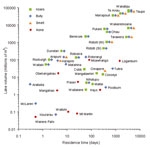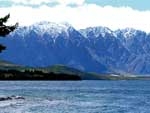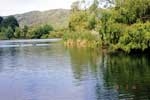PDF of this article (242 KB)






How much water does a fish need and how long does it need it? Jody Richardson and Alistair McKerchar combine some NIWA databases to learn more about native fish populations and their habitat requirements.
As New Zealand’s population increases, so does our demand for fresh water – to drink, to produce electricity, and to irrigate crops. This means many rivers and streams may be scrutinised for their developmental potential, including the feasibility of building dams to create large storage reservoirs. But dams can block the migrations that many of New Zealand’s native fish make between the sea and fresh water to complete their life cycles. However, some migratory species can also form land-locked populations provided there is a lake downstream. In these cases, the lake provides conditions similar to the sea for rearing the early life stages.
Residence time is how long water takes to travel through an impounded water body, such as a hydro lake or a reservoir. We wondered if residence time influences the development of land-locked populations of certain native fish species. If water moves quickly through a lake, then there might be more risk of larvae washing downstream and out of the system, or perhaps the food supply for larval fish might be affected. Low residence times might also affect the quantity and quality of spawning habitat for some species, particularly if combined with large fluctuations in lake level.
Fishing for data
To investigate the influence of residence time on land-locked fish populations, we chose three commonly occurring native fish that readily form such populations – koaro (Galaxias brevipinnis), common bully (Gobiomorphus cotidianus), and common smelt (Retropinna retropinna) – and compared their presence or absence with residence times for a range of natural and man-made lakes. We went to the New Zealand Freshwater Fish Database to get koaro, bully, and smelt data for 40 lakes with significant downstream obstacles (either natural or man-made).
This particular set of lakes was selected because water volume information was available for them from the Inventory of New Zealand Lakes, the New Zealand Dam Inventory, and other sources. To calculate residence times, we divided lake volumes by their mean discharges, as assessed from flow records or estimated from the River Ecosystem Classification database. We then looked for significant differences in the residence times of lakes with and without populations of our three fish species.
Residence times for our set of 40 lakes varied from a matter of hours for some of the hydroelectric reservoirs to more than 10 years for some of New Zealand’s large natural lakes. As we expected, there was a strong correlation between lake volume and residence time, with small lakes having significantly shorter residence times than large lakes.
Koaro
Residence time was a good predictor of whether or not there were land-locked populations of koaro. Lakes with koaro had an average residence time of 1073 days while lakes without koaro had an average time of 177 days, and these averages were significantly different (Kruskal-Wallis P = 0.005 for those readers interested in statistics).
Lake volume was also an important factor: if residence time was less than 80 days and the lake volume was less than 10 million cubic metres, then koaro were apparently unable to establish land-locked populations.
However, if residence time was more than 400 days and volume greater than 200 million cubic metres, koaro were always present. Lakes with low residence times (less than 10 days) that contained koaro had volumes in excess of 50 million cubic metres. The small lakes (less than 20 million cubic metres) that supported koaro populations were primarily water storage reservoirs, and all had native bush catchments. This might reflect the presence of well shaded tributaries that are necessary for koaro spawning.
Smelt
Residence time was also a good predictor for smelt populations, with lakes containing them having significantly longer residence times on average (1777 days) than lakes without (320 days, Kruskal-Wallis P = 0.015). Smelt were usually missing from lakes if residence time was less than 400 days, and always absent if the lake was also small (less than 20 million cubic metres). However, smelt were not found in a number of large lakes with long residence times in the upper Waitaki and Clutha catchments, probably because they were not present there naturally and have never been liberated to establish a food source for trout.
Common bully
Common bully were found in 25 of the 40 lakes, but there was no relationship between residence time and the presence of bully populations within this set of lakes (Kruskal-Wallis P = 0.458). However, volume was a significant predictor, with lakes containing bully being larger on average (9050 million cubic metres) than lakes without bully (20 million cubic metres, Kruskal-Wallis P = 0.0003). Why this should be so is unclear, but, for some of the small lakes with medium residence time, it might reflect competition with, or predation by, the local koaro populations.
So, what’s going on?
The larval habits of these species partially indicate why residence time influences their ability to form land-locked populations. Larval bullies in lakes are typically found as a layer in water 5 to 20 m deep, and tend to move vertically up and down at dawn and dusk. Koaro and smelt larvae are more widely dispersed through the water column, and are larger and better swimmers than bullies. They may be sensitive to flows or currents within lakes, moving both horizontally and vertically to avoid currents. Small lakes with low residence times are likely to have more current flowing through them and therefore may be less suitable for koaro and smelt larvae.
Our analysis indicates lake residence time can be used as a guide to predict whether land-locked populations of koaro and smelt can become established, but that lake volume and other factors, such as having suitable spawning sites or competition between species, might also influence their presence. A larger database might help us understand the relationships, but establishing a larger database may be limited by a lack of data on lake water volumes.
Key to land-locked populations
- Human requirements for fresh water can conflict with the habitat requirements of native fish.
- Some fish can adapt to barriers and impoundments in their waterways and form land-locked populations.
- A comparison of 40 lakes and 3 fish species shows how much water is needed for fish populations to form.
Jody Richardson works with native freshwater fish at NIWA in Hamilton and manages the New Zealand Freshwater Fish Database. Alistair McKerchar is based at NIWA in Christchurch, where his research includes hydrology and water resources.
Teachers’ resource for NCEA Achievement Standards or Unit Standards: Biology Level 3 AS90716, US8933 Science Level 3 US8153 See other curriculum connections at www.niwa.co.nz/pubs/wa/resources
